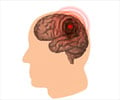Pericytes are cells that control blood flow in capillaries and these cells can be saved to reduce long-term brain damage caused by stroke, reports a new study led by scientists from UCL.

The study, published this week in Nature, shows not only that pericytes are the main regulator of blood flow to the brain, but also that they tighten and die around capillaries after stroke. This significantly impairs blood flow in the long term, causing lasting damage to brain cells. The team of scientists from UCL, Oxford University and the University of Copenhagen showed that certain chemicals could halve pericyte death from simulated stroke in the lab, and hope to develop these into drugs to treat stroke victims.
"At present, clinicians can remove clots blocking blood flow to the brain if stroke patients reach hospital early enough," explains Professor David Attwell of UCL's Department of Neuroscience, Physiology & Pharmacology, who led the study. "However, the capillary constriction produced by pericytes may, by restricting the blood supply for a long time, cause further damage to nerve cells even after the clot is removed. Our latest research suggests that devising drugs to prevent capillary constriction may offer new therapies for reducing the disability caused by stroke."
"This discovery offers radically new treatment approaches for stroke," says study co-author Professor Alastair Buchan, Dean of Medicine and Head of the Medical Sciences Division at Oxford University. "Importantly, we should now be able to identify drugs that target these cells. If we are able to prevent pericytes from dying, it should help restore blood flow in the brain to normal and prevent the ongoing slow damage we see after a stroke which causes so much neurological disability in our patients."
The new research also gives insight into the mechanisms underlying the use of functional magnetic resonance imaging to detect blood flow changes in the brain.
"Functional imaging allows us to see the activity of nerve cells within the human brain but until now we didn't quite know what we were looking at," explains Professor Attwell. "We have shown that pericytes initiate the increase in blood flow seen when nerve cells become active, so we now know that functional imaging signals are caused by a pericyte-mediated increase of capillary diameter. Knowing exactly what functional imaging shows will help us to better understand and interpret what we see."
 MEDINDIA
MEDINDIA




 Email
Email










